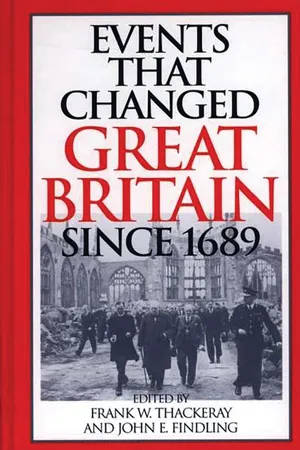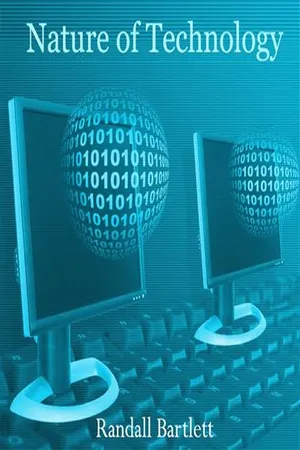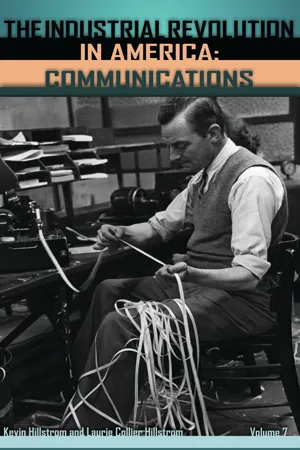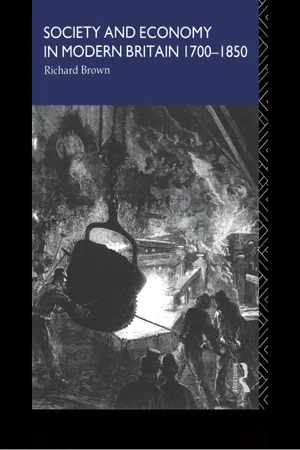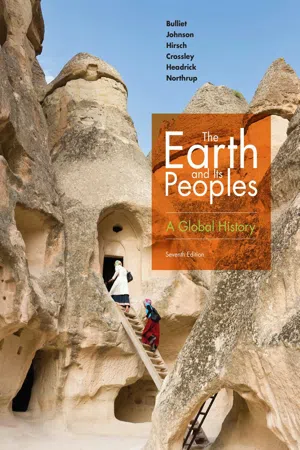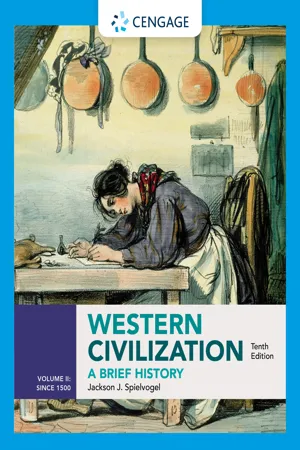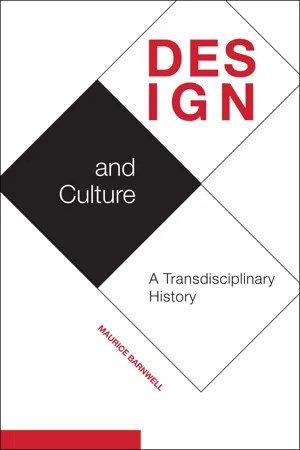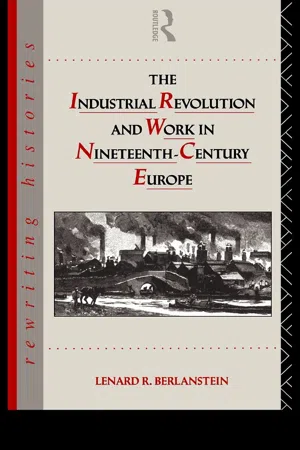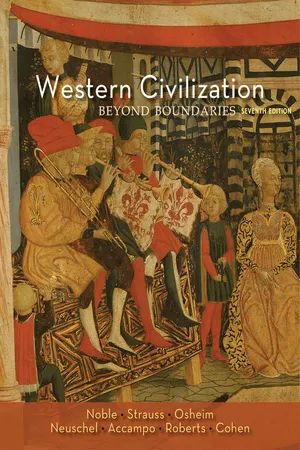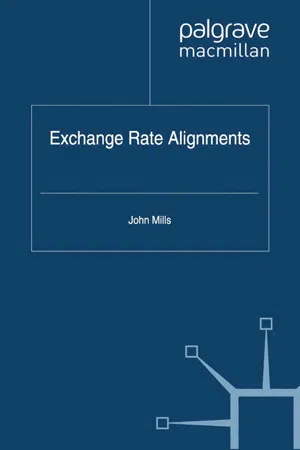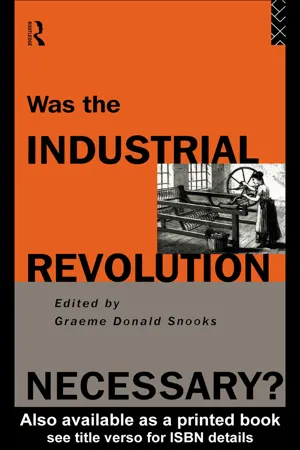History
The Industrial Revolution
The Industrial Revolution was a period of major technological, economic, and social change that began in the late 18th century. It marked the transition from agrarian and handcraft-based economies to industrial and machine-based manufacturing. This era saw the development of new inventions, such as the steam engine and spinning jenny, which revolutionized production processes and led to urbanization and significant societal shifts.
Written by Perlego with AI-assistance
Related key terms
1 of 5
12 Key excerpts on "The Industrial Revolution"
- eBook - PDF
- Frank W. Thackeray, John E. Findling, Frank W. Thackeray, John E. Findling(Authors)
- 2002(Publication Date)
- Greenwood(Publisher)
1 The Industrial Revolution, c. 1750-c, 1850 INTRODUCTION The word revolution often conjures up images of mobs roving the streets of major cities, peasants burning manor houses, armed bands clashing with uniformed troops, and crowned heads rolling in the dust to the delight of their mortal enemies. By this standard, The Industrial Revolution could hardly be considered a revolution. It was not a sudden and violent over- throw of the prevailing status quo; rather, it was a slow, drawn-out process that proved to be by and large peaceful in nature. Nevertheless, the Indus- trial Revolution altered the world more profoundly than anything since the development of agriculture many thousands of years ago. What was The Industrial Revolution? Basically, it was a transformation from the production of goods by hand to the production of goods by ma- chine. It also included a growing concentration of machines within single structures or series of connected structures called factories. The Industrial Revolution began in Great Britain about the middle of the eighteenth cen- tury and gradually spread throughout the world. It continues to evolve to- day as nonindustrialized countries struggle to industrialize and industrialized ones adopt new and more efficient technologies. A unique set of circumstances combined to provide fertile ground for The Industrial Revolution in eighteenth-century Great Britain. For a start, Brit- The power looms for weaving pictured here greatly accelerated the production of textiles. Although The Industrial Revolution provided employment and a rising standard of living, factories were not as clean and orderly as this prmt might suggest. Reproduced from the Collections of the Library of Congress Industrial Revolution 3 ain was blessed with an abundance of natural resources necessary for the industrialization process. - Joel Mokyr(Author)
- 2018(Publication Date)
- Routledge(Publisher)
1 The Industrial Revolution and the New Economic History JOEL MOKYR 1 Almost a century has passed since the publication of Arnold Toynbee’s famous Lec-tures on The Industrial Revolution (1884).2 Historians of all persuasions have since come to the conclusion that The Industrial Revolution in Britain constituted a new point of departure in human history, an event of such moment to daily life that it compares to the advent of monotheism or the development of language. Conse-quently, a vast literature has emerged dealing with its various aspects, written by his-torians, economists, and sociologists, both left wing and right wing, English and foreign. Little agreement has emerged among the experts about the fundamental questions. There is, first, the mere question of definition: what exactly was the Indus-trial Revolution?3 Of the many attempts to sum up what The Industrial Revolution meant, Perkin’s is perhaps the most eloquent. In his words, it was “a revolution in men’s access to the means of life, in control of their ecological environment, in their capacity to escape from the tyranny and niggardliness of nature ... it opened the road for men to complete mastery of their physical environment, without the inesca-pable need to exploit each other” (Perkin, 1969, pp. 3-5). More changed in Britain than just the way in which goods and services were produced. The nature of family and household, the status of women and children, the role of the church, how people chose their rulers and supported their poor, what they knew about the world and what they wanted to know-all of these were transformed. It is a continuing project to discover how these noneconomic changes affected and were affected by economic change. The Revolution was, in Perkin’s irresistible phrase, a “more than industrial revolution.” By focusing on economics we isolate only a part, though a central part, of the modernization of Britain.- No longer available |Learn more
- (Author)
- 2014(Publication Date)
- Orange Apple(Publisher)
Trade expansion was enabled by the introduction of canals, improved roads and railways. The introduction of steam power fuelled primarily by coal, wider utilisation of water wheels and powered machinery (mainly in textile manufacturing) underpinned the dramatic increases in production capacity. The development of all-metal machine tools in the first two decades of the 19th century facilitated the manufacture of more production machines for manufacturing in other industries. The effects spread throughout Western Europe and North America during the 19th century, eventually affecting most of the world, a process that continues as industrialisation. The impact of this change on society was enormous. The first Industrial Revolution, which began in the 18th century, merged into the Second Industrial Revolution around 1850, when technological and economic progress gained momentum with the development of steam-powered ships, railways, and later in the 19th century with the internal combustion engine and electrical power generation. The period of time covered by The Industrial Revolution varies with different historians. Eric Hobsbawm held that it 'broke out' in Britain in the 1780s and was not fully felt until the 1830s or 1840s, while T. S. Ashton held that it occurred roughly between 1760 and 1830. Some 20th century historians such as John Clapham and Nicholas Crafts have argued that the process of economic and social change took place gradually and the term revolution is a misnomer. This is still a subject of debate among historians. GDP per capita was broadly stable before The Industrial Revolution and the emergence of the modern capitalist economy. The Industrial Revolution began an era of per-capita economic growth in capitalist economies. Economic historians are in agreement that the onset of The Industrial Revolution is the most important event in the history of humanity since the domestication of animals and plants. - eBook - PDF
The Industrial Revolution in America
Communications, Agriculture and Meatpacking, Overview/Comparison [3 volumes]
- Kevin Hillstrom, Laurie Collier Hillstrom, Kevin Hillstrom, Laurie Collier Hillstrom(Authors)
- 2007(Publication Date)
- ABC-CLIO(Publisher)
The changing of the seasons governed all aspects of daily life in the preindustrial era, and towns, cities, and states that lay a mere hundred miles distant seemed nearly as foreign and exotic as those of Europe or the Far East. The Industrial Revolution changed all that. As railroad networks, steam shipping routes, textile factories, telegraph and telephone lines, steel foundries, and mechanized harvesting machines blossomed across the land, they transfigured American life. Major metropolitan centers sprang up across the land, even in areas of the interior that had been wholly unsettled a mere quarter century before. Subsistence economies gave way to vibrant commercial economies based on national and international trade, and the land’s natural bounty was exploited with near-religious zeal. American culture and self-identity underwent similarly profound changes, nurtured by the seeming fulfillment of the Manifest Destiny doctrine, spiraling tensions between workers and employers, and dawning awareness of the nation’s ever-growing influence and stature on the global stage. vii In recognition of the profound impact that The Industrial Revolution had on the United States and the wider world, ABC- CLIO has created The Industrial Revolution in America. This nine- volume series covers all aspects of the American Industrial Revolution, from the introduction of steam-powered engines to the emergence of the automobile. In the process, the series provides a wealth of fascinating, detailed information on the historical impact of various industries on the nation’s workers, families, and communities. It also casts a discerning eye on the various ways in which these industries shaped U.S. politics, corporate practices, philosophies of natural resource use and stewardship, and cultural development. Coverage in The Industrial Revolution in America is broken down into the following subject-specific volumes: Iron and Steel. - eBook - ePub
- Richard Brown(Author)
- 2002(Publication Date)
- Routledge(Publisher)
12 The economic revolutions—an overviewThe ‘forces’ operating in history cannot be defined or put in abstract terms, but one can behold them, observe them, and develop a sympathy for their existence.1Harold Perkin wrote in 1969 thatBetween 1700 and 1850 major change occurred in people’s experience and perception of the economic worlds in which they lived. These changes are often encapsulated in the concept of an ‘industrial revolution’. The previous nine chapters have examined change from a much broader viewpoint, relating changes in population, communications, agriculture, trade, banking, finance and industrial organization to ‘revolutionary’ and ‘non-revolutionary’ industrial innovation. This chapter will attempt to draw together this discussion and raise questions about the historiography of industrial change. It will pose a series of questions which place the economic revolutions in a conceptual framework.It was a revolution in men’s access to the means of life, in control of their physical environment, it opened the road for men to complete mastery of their physical environment without the inescapable need to exploit each other…it was more than an industrial revolution.2Perkin and many other historians have written much about The Industrial Revolution as the ‘great discontinuity’, the divide between what Peter Laslett called a ‘world we have lost’ and the modern world. In popular imagination it is supposed to have ended traditional society in England and initiated fundamental social change. It is supposed to have completely altered people’s lives, liberating them from the constraints of Nature and, for the first time, giving them control over their environment. The cotton mill powered by steam epitomized both the promise and the exploitation of the ‘new’ economic order. How accurate a representation of the past are these perspectives and why have historians adopted them? - eBook - PDF
The Earth and Its Peoples
A Global History
- Richard Bulliet, Pamela Crossley, Daniel Headrick, Steven Hirsch(Authors)
- 2018(Publication Date)
- Cengage Learning EMEA(Publisher)
industrial areas Scattered ironworks N 0 0 100 200 Mi. 100 200 Km. Copyright 2019 Cengage Learning. All Rights Reserved. May not be copied, scanned, or duplicated, in whole or in part. Due to electronic rights, some third party content may be suppressed from the eBook and/or eChapter(s). Editorial review has deemed that any suppressed content does not materially affect the overall learning experience. Cengage Learning reserves the right to remove additional content at any time if subsequent rights restrictions require it. 22-3 The Impact of the Early Industrial Revolution 571 the transmission of news from up to four days to a matter of minutes); it was the beginning of a network that eventually connected the entire globe. No longer were communications limited to the speed of a sailing ship, a galloping horse, or a fast-moving train. Together railroads and tele-graphs had an enormous economic impact. While railroads could move bulk goods more rapidly and at lower cost than other forms of land transportation, telegraphs dramatically transformed market intelligence by making it possible for producers to keep track of distant consumer needs and prices, thus making markets more efficient and profits more dependable. 22-3 The Impact of the Early Industrial Revolution What was the impact of these changes on the society and environment of the industrializing countries? The Industrial Revolution led to profound changes in society, politics, and the economy. At first, the changes were local. Some people became wealthy and built mansions, while others lived in slums with polluted water and air. By the mid-nineteenth century, the worst local effects were being alleviated and cities had become cleaner and healthier. Industrial nations then faced more complex problems: business cycles, labor conflicts, and the environmental degradation of entire regions by mining and industrial pollution. - eBook - PDF
Western Civilization
A Brief History, Volume II since 1500
- Jackson Spielvogel(Author)
- 2019(Publication Date)
- Cengage Learning EMEA(Publisher)
In another fifty years, both Germany and the United States would surpass Britain in industrial production. 20-1a Origins of The Industrial Revolution A number of factors or conditions came together in Britain to produce the first Industrial Revolution. down to take a moment’s ease, and being seen by the manager, were fined for the offense.” But there were also examples of well-run factories. William Cobbett described one in Manchester in 1830: “In this room, which is lighted in the most convenient and beautiful manner, there were five hundred pairs of looms at work, and five hundred persons attending those looms; and, owing to the goodness of the masters, the whole looking healthy and well-dressed.” During The Industrial Revolution, Europe expe- rienced a shift from a traditional, labor-intensive economy based on farming and handicrafts to a more capital-intensive economy based on manufacturing by machines, specialized labor, and industrial factories. Although The Industrial Revolution took decades to spread, it was truly revolutionary in the way it funda- mentally changed Europeans, their society, and their relationship to the rest of the world. The development of large factories encouraged mass movements of people from the countryside to urban areas where impersonal coexistence replaced the traditional intimacy of rural life. Higher levels of productivity led to a search for new sources of raw materials, new consumption patterns, and a revolution in transportation that allowed raw materials and finished products to be moved quickly around the world. The rise of a wealthy industrial middle class and a huge industrial working class (or proletariat) substantially transformed traditional social relationships. One of these was the agricultural revolution of the eighteenth century, which led to a significant increase in food production. - eBook - PDF
Design and Culture
A Transdisciplinary History
- Maurice Barnwell(Author)
- 2021(Publication Date)
- Purdue University Press(Publisher)
1 INDUSTRIAL REVOLUTION 1750–1870 Steam, Iron, and Glass FROM FIELD TO FACTORY Agriculture was the prime economic force in Britain for centuries — its dominance began to wane with the beginning of The Industrial Revolution. 1 Thomas Carlyle, a young, unknown Scottish writer, composed “Signs of the Times,” which was published in the Edinburgh Review in June 1829. The phrase found popular support among prominent novelists of the day. “A lengthy era of rural, agronomic civilization was chang-ing precipitously. Opinions and beliefs that had seemed fixed certainties and were almost univer-sally shared became broadly challenged. Profound changes in science and technology fostered and fueled stunningly swift changes in the ways in which multitudes of people gained their living, organized their lives, and conducted their expe-rience.” 2 Carlyle’s concerns were repeated in his later works Chartism (1839) and Past and Pres-ent (1843). Carlyle was not alone. Three other distin-guished writers, Friedrich Engels, William Cob-bett, and Benjamin Disraeli, as well as novelists Thomas Hardy, Charles Dickens, Elizabeth Gas-kell, and George Eliot (Mary Ann Evans), were also critics of the times. All foresaw the dra-matic and fundamental changes that would be created by industrial capitalism and that “its im-pact was not only economic, but also cultural, bringing the nation to the very brink of a preci-pice.” 3 Here is but one representative quote from Thomas Carlyle: Were we required to characterise this age of ours by any single epithet, we should be tempted to call it, not an Heroical, Devo-tional, Philosophical, or Moral Age, but, above all others, the Mechanical Age. It is the Age of Machinery, in every outward and inward sense of that word; the age which, with its whole undivided might, forwards, teaches and practises the great art of adapt-ing means to ends. Nothing is now done directly, or by hand; all is by rule and calcu-lated contrivance. - Lenard R. Berlanstein(Author)
- 2003(Publication Date)
- Routledge(Publisher)
Not long ago, historians thought, and taught, a Europe peopled mainly by an immobile, traditional peasant mass, dominated by church and state, which broke apart after 1750 with an industrial revolution followed by a series of democratic revolutions. The Industrial Revolution AND WORK 47 Witness the 1950 edition of Robert R. Palmer’s first-rate survey, A History of the Modern World. 1 Palmer’s presentation of modern Europe outside of Italy begins with the fifteenthcentury New Monarchs (Henry VII, Louis XI and others) who established royal power and stable government, and thus laid a political foundation for a commercial revolution. The commercial revolution includes an expansion of cottage industry, . in which rural people produced at home on orders from local merchants. As a result of rising prices, peasants prospered and landlords faltered in western Europe; in eastern Europe, however, landlords themselves retained control of production, thereby taking advantage of price rises while subordinating manorial workers to their personal control. Palmer’s reconstruction continues: as monarchs fortified their states for war, conquest and internal control, worldwide exploration and the growth of scientific thinking combined to generate prosperity and modern ways: the greatest social development of the eighteenth century, with the possible exception of the progress of knowledge, was the fact that Europe, or the Atlantic region of Europe north of Spain, became incomparably more wealthy than any other part of the world. The new wealth, in the widest sense, meaning conveniences in every form, was produced by the increasing scientific and technical knowledge, which in turn it helped to produce; and the two together, more wealth and more knowledge, helped to form one of the most far-reaching ideas of modern times, the idea of progress.- eBook - PDF
Western Civilization
Beyond Boundaries
- Thomas F. X. Noble, Barry Strauss, Duane Osheim, Kristen Neuschel(Authors)
- 2013(Publication Date)
- Cengage Learning EMEA(Publisher)
Scientific and rational methods altered production processes, removing them from the home—where entire families had often participated—to less personal workshops and factories. Significant numbers of workers left farming to enter mining and manufactur- ing, and major portions of the population moved from rural to urban environments. Machines replaced or supplemented manual labor. * Mechanical production often meant that skilled artisans lost not only their livelihood but their craft identity as well; it also drew women and children out of the home and into factories. New modes of production offered unprecedented opportunities for manufac- turers, merchants, and entrepreneurs to create and amass wealth at levels previously unimaginable. Mechanization also caused pollution and environmental destruction. The Industrial Transformation of Europe, 1750–1850 Preconditions for Industrialization ◆ ◆ What factors allowed Europe to industrialize before the rest of the world? New Modes of Production ◆ ◆ Which inventions appear to have been the most important in launching industrialization? Social, Cultural, and Environmental Impacts ◆ ◆ What impact did industrialization have on the environment and on social classes? Responses to Industrialization ◆ ◆ What did workers gain and lose as a result of industrialization, and how did they respond? Chapter Overview 20 *Phyllis Deane, The First Industrial Revolution (Cambridge: Cambridge University Press, 1965), p. 1. Copyright 2012 Cengage Learning. All Rights Reserved. May not be copied, scanned, or duplicated, in whole or in part. Due to electronic rights, some third party content may be suppressed from the eBook and/or eChapter(s). Editorial review has deemed that any suppressed content does not materially affect the overall learning experience. Cengage Learning reserves the right to remove additional content at any time if subsequent rights restrictions require it. - eBook - PDF
- J. Mills(Author)
- 2012(Publication Date)
- Palgrave Macmillan(Publisher)
In varying degrees they were in touch with at least some of the cultural and intellectual currents affecting Europe. The state which came closest to breaking through into industrialisation was fifteenth-century China, but the progress made was snuffed out by the country’s leaders, who turned back to traditional ways. 11 India, on the other hand, showed no more signs of sustained industrial development than the Romans, despite the ability of the Mughal culture to build the Taj Mahal, its high point of excellence in design and execution. Nor were smaller nations elsewhere any better at producing sustained economic growth. It was in Europe, with its large number of relatively small states, that there began a cumulative increase in living standards, starting early in the second millennium, which eventuated in The Industrial Revolution and the transformation of humanity’s prospects which it brought in train. 108 Exchange Rate Alignments Early industrialisation in Europe Thus, The Industrial Revolution, which began in Europe in the eight- eenth century, rested on a foundation built over hundreds of years. Since at least the fourteenth century, Europe had seen a slow increase in output per head, set back from time to time by pestilence, bad govern- ment and war’s devastation. Growth had come about partly from improved agriculture, partly from increased trade based on the avail- ability of an adequate credit system, but mainly from the application of ideas, some based on novel technology, to a wide variety of production processes. The advent of the printing press vastly reduced the cost of produ- cing books and thus of disseminating knowledge. Developments in ship design and navigation greatly decreased the costs of trading and opened up access to large sections of the world previously unknown to Europeans. The resulting exchange of products enabled gains from never-before- available specialisation in the production of goods and agricultural products. - eBook - ePub
- Graeme Snooks(Author)
- 2012(Publication Date)
- Routledge(Publisher)
78 It is possible that in the very near future we will be facing a natural resources constraint as serious as that which prevailed throughout the later Middle Ages. If so it may take a change in technology and social organization as major and as unpredictable as that of The Industrial Revolution to prevent prolonged stagnation and instability.WHAT ARE THE IMPLICATIONS OF A FORWARD-LOOKING PERSPECTIVE?By placing The Industrial Revolution within the context of economic change during the last millennium we do gain a different perspective on this great event in human history. In the first place, it is suggested in this chapter that rapid and sustained rates of economic growth are not a modern invention. In terms of rates of economic growth, The Industrial Revolution was not a radical departure from what had been experienced in the periods 1000 to 1300 and, particularly, the sixteenth century. It has also been argued that growth over the last millennium has been a systematic process—a process of continuous transformation—rather than a series of random events. And this systematic growth process has proceeded via a succession of ‘great waves’ of economic change, of up to 300 years in duration.This wave-like growth process, which has involved a positive relationship between population and real GDP per capita, is driven by fundamental endogenous economic forces rather than by exogenously determined demographic forces. And a major actor in this process is economic man. But this endogenous process is subject to exogenous shocks in the form of pestilence and war, both civil and from foreign aggression. This view is to be contrasted with those that characterize longrun growth as being exogenously determined by an impact upon mortality and proceeding via inverse longrun swings in population and real GDP per capita. Growth, therefore, should be viewed not as a result of random events, but rather as a natural internally generated outcome of competitive societies.This continuous process of economic transformation was achieved in different ways in different periods. Longrun growth is not just a function of industrialization. For example, during the period 1000 to 1300, while there was a slow improvement in the technological foundations of agriculture, urban activities, and transport, the major part of this growth was due to the emergence of factor markets (particularly for labour and capital), and the widening of commodity markets, all of which reduced transactions costs.79
Index pages curate the most relevant extracts from our library of academic textbooks. They’ve been created using an in-house natural language model (NLM), each adding context and meaning to key research topics.
